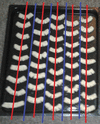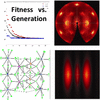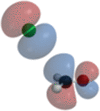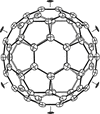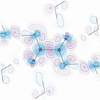issue contents
June 2022 issue
Special issue on structure correlation and dynamics in crystals – a birthday tribute to Hans-Beat Bürgi
Guest Editors: Simon Grabowsky and Mark A. Spackman

Cover illustration: Hans-Beat Bürgi teaching in the early 1970s. On the blackboard is a sketch of the nucleophilic attack at carbonyls.
Hans-Beat Bürgi tribute
Free 

Structure correlation, dynamics and disorder in crystals have been major research topics throughout Hans-Beat Bürgi's career that is celebrated in this special issue.
A personal view on crystal structures is offered: past and present, ordered and disordered, static and dynamic, and problems solved and open.
This essay outlines of the binding interactions between Hans-Beat Bürgi and Roald Hoffmann, and a potential rearrangement of their molecules is considered.
Memories of the scientific collaboration over several decades of the crystallographers at the Universities of Bern and Lausanne are shared.
Collaborative work at the University of Strasbourg in the 1970s is remembered.
Some comments concerning the meaning and significance of X-ray constrained/restrained wavefunctions are given.
A brief review of bone hierarchical structure is given. Recent findings that have resulted from X-ray imaging are highlighted.
Methods for reconstructing `experimental model wavefunctions' from X-ray data are reviewed and clarified, and the key problem of deciding when to terminate the wavefunction reconstruction procedure is defined as 'the halting problem'. The role of Hans-Beat Bürgi in all of this is described.
Advanced simulation methods are used to portray the structural, static and dynamic aspects of the rotations of methyl and trifluoromethyl groups, as well as entire molecules, in their crystals at equilibrium.
The paper describes how the calculation of diffuse scattering from atomistic model crystals has developed over the last approximately 50 years.
Diffuse scattering and inelastic scattering were probed by X-rays and compared for inorganically formed natural calcite and biogenic calcite from the sea urchin spine. The differences in the mechanical properties between the `strong' biogenic and `brittle' abiotic material are attributed to a mesoscopic architecture of the spine.
Multi-temperature synchrotron powder diffraction data are used to characterize the crystal structure of thermoelectric clathrate Ba7.74 (9)Ce0.26 (9)Au5.42 (3)Si40.58 (3).
Reported here is a new metastable phase in flash-frozen disordered Prussian blue analogues characterised by the appearance of diffuse scattering clouds and reduction of the cubic symmetry to a tetragonal or lower space group.
Download citation


Download citation


Open  access
access
 access
accessThe normal mode analysis of variable-temperature anisotropic atomic displacement parameters (ADPs) of the α-phase of 1,1-diamino-2,2-dinitroethylene (DADNE or FOX-7) is reported.
Open  access
access
 access
accessSingle-crystal diffuse scattering measurements are used to study the interplay of short-range anion order and anharmonic lattice dynamics in the series KCl1–xBrx.
Download citation


Download citation


X-ray radiation damage increases unit-cell volume, apparent anisotropic displacement parameters and shifts the spin state equilibrium to lower temperatures. It may therefore serve as another tool to tune a spin transition sequence.
Download citation


Download citation


The electron density in α-oxalic acid obtained from an experimental wavefunction analysis on multiple experiments is analysed and the improvements are compared to previous work from twenty years ago.
CCDC reference: 2144303
Download citation


Download citation


Open  access
access
 access
accessThe enantiotropic relationship between the four polymorphs of pyrazinamide is analyzed by means of accurate X-ray diffraction measurements, normal-mode refinement and periodic DFT calculations.


 journal menu
journal menu








